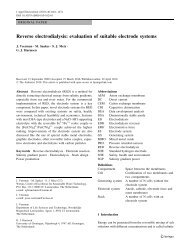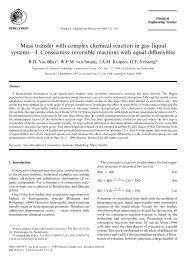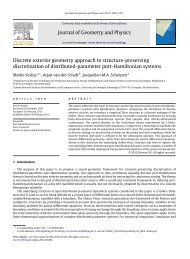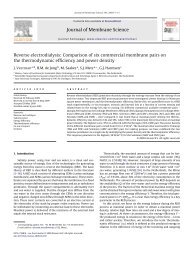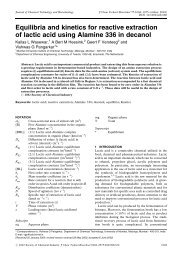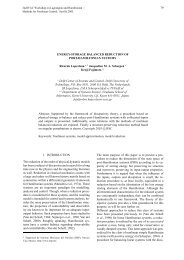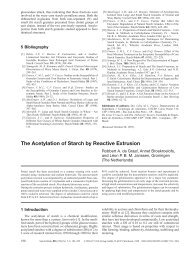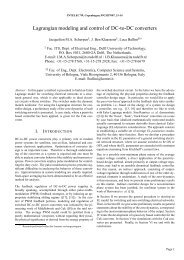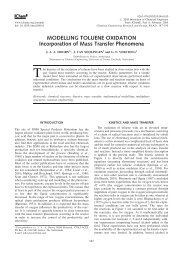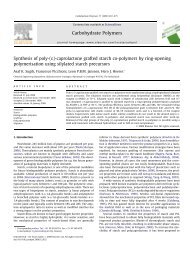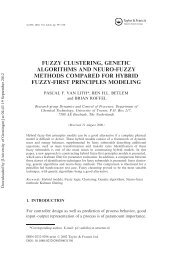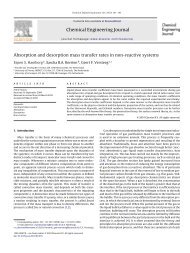Lyapunov-Based Control Scheme for Single-Phase Grid ... - ITM
Lyapunov-Based Control Scheme for Single-Phase Grid ... - ITM
Lyapunov-Based Control Scheme for Single-Phase Grid ... - ITM
You also want an ePaper? Increase the reach of your titles
YUMPU automatically turns print PDFs into web optimized ePapers that Google loves.
522 IEEE TRANSACTIONS ON CONTROL SYSTEMS TECHNOLOGY, VOL. 20, NO. 2, MARCH 2012rameters of this model can be defined as, and , where andare the number of PV cells connected in series and parallel,respectively.B. Power Conditioning SystemThe schematic diagram of the full-bridge central inverter configurationis shown in Fig. 1. Here and are the averagevalues of the input capacitor voltage and the output inductor current,respectively. The utility grid voltage is assumed to besinusoidal with a constant amplitude and a constant frequency, i.e., . The full-bridge inverter consists of fourswitches controlled by the signals and which take values inthe discrete set (i.e., OFF or ON, respectively). The switchcontrol signals are generated via a PWM scheme with a dutyratio functiongenerated by the controller. Thismeans that if the switching frequency is sufficiently high, thedynamical behavior of the GPV system can be approximated bythe following set of differential equations:(4)(5)The latter equations will be used to design a controller <strong>for</strong> thesystem, where we assume that the only unknown parameter is. The controller should be able to deal with this parameteruncertainty.III. CONTROLLER DESIGNA. <strong>Control</strong> ObjectivesThe GPV inverter of Fig. 1 should be able to transfer efficientlythe maximum amount of PV energy to the utility grid. Inorder to accomplish that the following is required.C1) to deliver a sinusoidal current in phase with the utilityvoltage of the power grid;C2) to regulate the input capacitor voltage to a value thatassures maximum power extraction from the PV array.With respect to C2, it should be mentioned that it is assumedthat the reference capacitor voltage value is given by an externalmaximum power point tracking (MPPT) algorithm. MPPT algorithmsoperate based on the changes of temperature and solarirradiance and there<strong>for</strong>e change very slowly compared to the dynamicsof the power inverter. For instance, slow varying MPPTs(variation time 20 ms), such as an extremum-seeking [30] orothers based on heuristic approaches [31] may be added to thisscheme without affecting the dynamic behavior of the analyzedclosed-loop system.<strong>Based</strong> on (4) and the notation presented in Section II, objectivesC1 and C2 translate into, whereand is the value of such that is maximum. Thepower generated by the PV panels equals .Ideally, should be a constant in order to assure that thePV array operating point remains always in its maximum power(6)point. However, due to the intrinsic nature of the inverter structureused it is not possible to have a sinusoidal output currentand a constant input voltage. This impossibility can be seen assumingthatand obtaining the energy-balanceequation of the system from (4)Notice that this expression is independent from the controlsignal . Substituting (6) into (7) yields(8)where we recall that .From (8) it is clear that has to be time-varying. Nevertheless,a time-varying is an undesired effect because it willmove the PV array operating point from its maximum powerpoint. A practical solution <strong>for</strong> this problem, widely used in thedesign of Central PV inverters, is to make sufficiently largeto reduce the oscillations towards the PV array maximum powerpoint. Indeed, as is shown next, obtained from (8) is a periodicsignal with an offset value , such that whenis sufficiently large 1 .For analysis convenience instead of consider the energystored in the capacitor, i.e.,and substitute itin (8) obtainingInstead of obtaining the exact analytical solution of (9) wewill solve its linearized version. Given that we will have a sufficientlylarge the linearization of (9) is a very good approximationas it will be shown. 2 Linearizing the nonlinear functionaround the dc value of (denoted as ) yieldswhereHence, (9) reduces to(7)(9)(10)(11)(12)1 Notice that having a C sufficiently large is a requirement <strong>for</strong> this type ofpower inverters, given that smaller values of C may reduce considerable theamount of energy extracted from the PV array.2 Take into account that this linearization process is only done in order to estimatethe wave<strong>for</strong>m of the desired steady-state value x and to verify that it isperiodic. In the remainder of the article we will be working with the nonlineardynamics of the system.



